Photographs by the author. [You may use these images without prior permission for any scholarly or educational purpose as long as you (1) credit the photographer and (2) link your document to this URL in a web project or cite it in a print one.]
A big thank you to Ralphy Jhirad, a Jewish resident of Mumbai, who took me round the city visiting the synagogues. He arranged for all the necessary permissions. Special thanks too to my Jewish friends in Kolkata, Jeal Siliman and Jo Cohen, for providing valuable contacts in Mumbai.

Synagogues of Mumbai. Left: Magen David; second left: Keneseth Eliyahoo; third left, top: Tiphearth Israel; third left, bottom: Magen Hassidim. Right top: Shaare Rason and Right bottom: Shaar Harahamim.
Mumbai (formerly Bombay) always had a large Jewish population and during the 1940s it reached its peak with a figure of almost 30,000 (for a history of Judaism in the city, and a detailed discussion of the Magen David Synagogue, please click here). Today the Mumbai Jews number about 3,500 and the city houses a total of nine synagogues. Out of the nine, six are in the downtown Mumbai area while the remaining three are on the outskirts of the city.
Four out of the six synagogues of downtown Mumbai belong to the Bene Israel community while the remaining two belong to the Bagdadi Jews. Most the downtown Mumbai Synagogues are basic places of worship and lack the grandeur of Kolkata’s magnificent synagogues of Magen David and Beth El.
Keneseth Eliyahoo Synagogue

Keneseth Eliyahoo Synagogue (literally meaning Gathering of Elijah) belongs to the Bagdai Jew community of Mumbai. It is an large and imposing synagogue located in the fort area of Mumbai. The synagogue was built in 1884 by Jacob Elias Sassoon and his brother Albert Sassoon in memory of their father Eliyahoo David Sassoon, who was the son of David Sassoon. David Sassoon was a Bagdadi Jew who settled in Mumbai (then Bombay) in 1832 and was a successful businessman and manufacturer.
The synagogue was designed by the British architectural firm Gostling & Morris. The exteriors are a combination of blue and white and it is known as Mumbai’s Blue Synagogue. The synagogue is a combination of Neo-Classical and Gothic-Victorian architecture. The exterior façade has corinthian columns and triangular pediments.

The interior is in neo-gothic style, with floral stained glass windows above the ark (heckal). The floor is laid with decorative tiles. The central wooden platform (bimah) is fitted with brass railings and ornamentation, including brass and glass dome lights projecting from the four corners. Several brass chandeliers light up the interior of the synagogue. The women’s gallery is located upstairs. Ornamental pillars support the women’s gallery, which runs around the three sides of the upper floor.
Shaar Harahamim Synagogue
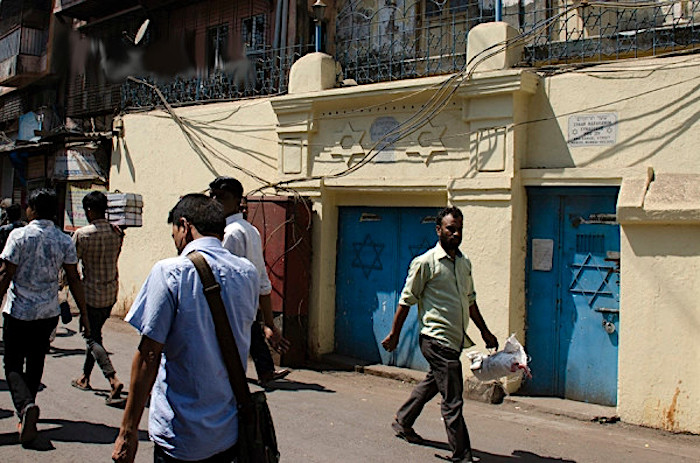
Shaar Harahamim Synagogue (literally meaning Gateway of Mercy) on Masjid Bhandar is the oldest synagogue in Mumbai. It dates back to 1796 and belongs to the Bene Israel group. The synagogue was originally constructed by the sole efforts of Jewish military officer Samuel Ezekiel Diveker of the Bombay Army. It came to be known as the Samaji Hasiji, or Samuel’s Synagogue. Due to shortage of space the old building had to be replaced with a new bigger building. The present building of the synagogue dates back to 1860. The synagogue was renamed Shaar Harahanin Synagogue during the centenary celebration in 1896.
The two-storey synagogue is located in a very congested area of south Mumbai and two marble plaques on the outer walls and a couple of stars of David on the walls and gate are the only signs that it is a synagogue. The interior (not visited yet) is described as having a grey marble floor and large windows. The plans are the same as those of other synagogues with a central pavilion and first floor ladies' balcony.
Share Rason Synagogue
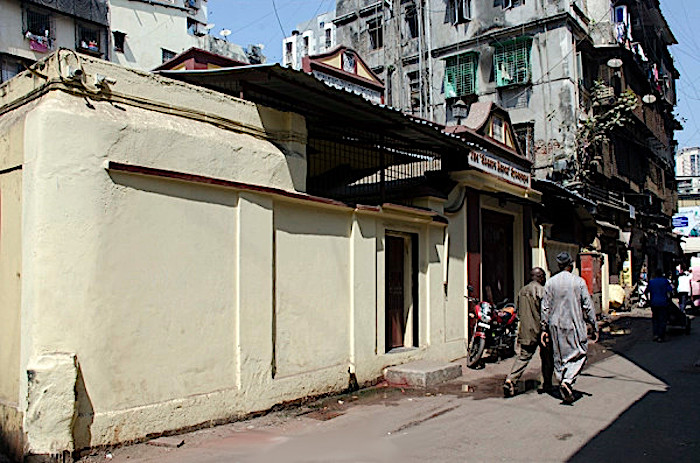
Share Rason Synagogue (literally meaning Gateway of Mercy) was constructed in 1843 and is the second oldest synagogue in Mumbai. It belongs to the Bene Israel community. It was built by a group formerly affiliated with the Shaar Harahanin Synagogue who have become dissatisfied with its management. To differentiate it, it was called the “New Synagogue,” while the Shaar Harahanin Synagogue became the “Old Synagogue.” In a congested area known as the Israel Mohalla, it is surrounded by a high wall with a main gate. The gate is surmounted by a pediment with an inscription and a pair of wooden doors opening into the synagogue compound.
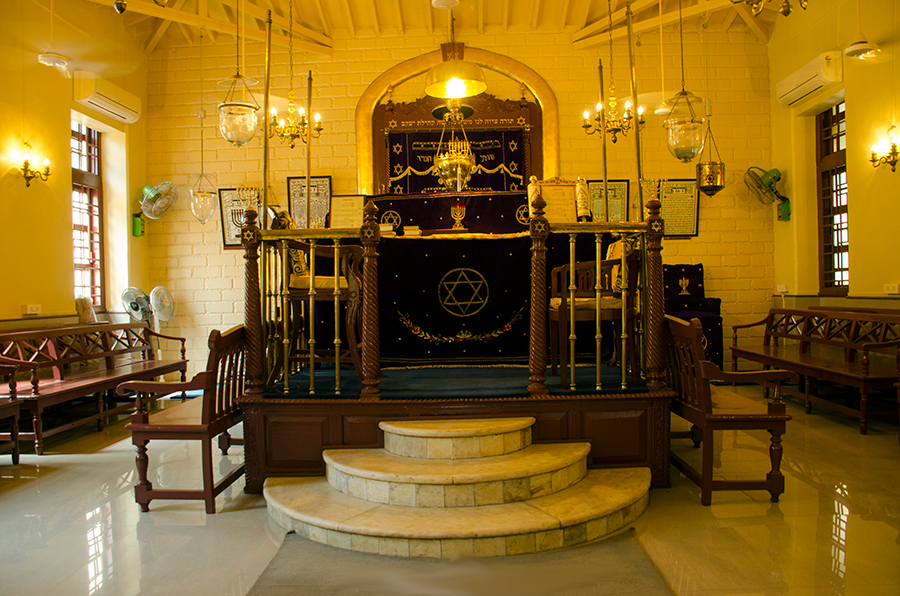
The synagogue has a single floor and the entrance is through the ladies' gallery. The wooden central pavilion is fitted with brass ornamentation. The corners of the pavilion are fitted with miniature menorah. The bright yellow painted walls and the chandelier light create a golden glow bathing the interior.
Magen Hassidim Synagogue
Magen Hassidim Synagogue (literally meaning Shield of the Pious) is the largest Bene Israel Synagogue in Mumbai. It is also the newest of all the six synagogues of downtown Mumbai. The Bene Israel congregation of Mumbai (then Bombay) started in 1904. They started operating from private and rented places for their prayers and religious service. Later Benjamin Samson Dandoolkar, one of the community members established a prayer hall which came to be known as Dandoolkar’s Prayer Hall. But soon it was short of place and in 1934 the community came up with the present prayer hall and named it Magen Hasidim Synagogue.
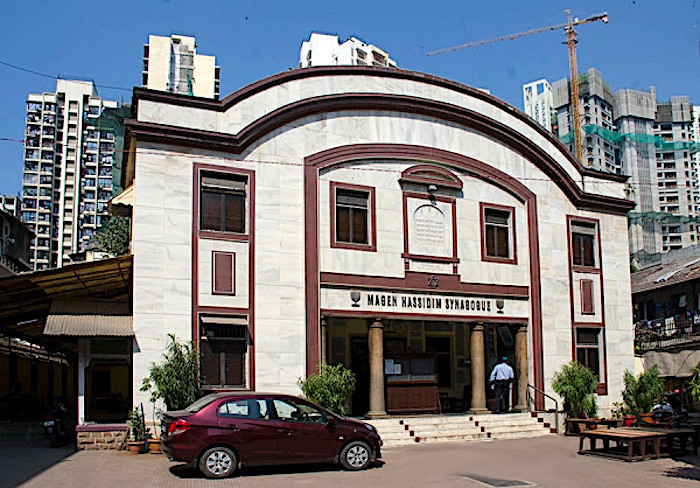
The two story structure has a vaulted ceiling, a recessed entry porch with a low set of steps. The centre has a Hebrew inscription of the ten commandments.The interiors are more lively with a decorative wooden central platform. The ladies' gallery is on the first floor balcony. Decorative chandeliers light up the interior with the large windows allowing the natural light to filter in.
Tiphereth Israel Synagogue
Tiphereth Israel Synagogue or Tifereth Israel Synagogue (literally meaning the Glory of Israel) located near the Jacob Circle is the third Bene Israel Synagogue in Mumbai. It started in 1886 as the Jacob Circle Prayer Hall and in 1896 it was renamed as Tephereth Israel Synagogue. In 1924 the community moved to a larger space due to the efforts of community member Aaron Benjamin Kandlekar. In Kandlekar’s honor for his generosity, the synagogue also became known as Kandlekaranchi Masjid or Kandlekar’s Synagogue. Today the Kandlekar family takes an active part in the running of the synagogue.
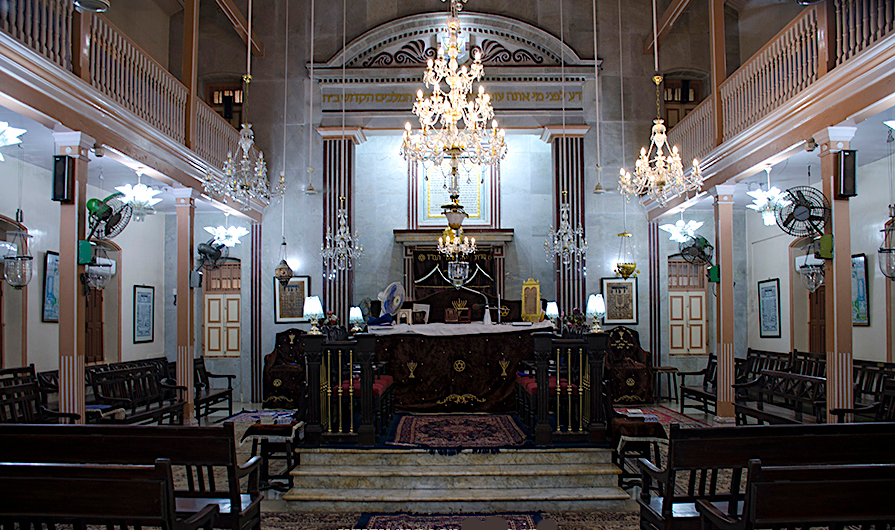
Over the years the synagogue has undergone several renovations with the last major one coming as late as 2000. It is on the ground floor with the ladies' gallery on the northern side. Hanging brass and glass lanterns, ceiling fans, decorative metal window grilles and wall scones are part of the grand interior. The central pavilion is surrounded by a wood and brass balustrade, with brass lamp shades on four corners.
Note:
Other Synagogues of Mumbai: Shaar Hashamaim Synagogue (Gateway of Heaven); Thane Beth El Synagogue (House of God); Panvel Magen Aboth Synagogue (Defender of Brothers), Alibug. Synagogue entry requirement: subject to permission. Each synagogue has its own board, so separate permissions are required. Still photography is allowed for a fee of ₹ 500.Related Material
Bibliography
Datta, Rangan. Synagogues of Downtown Mumbai on Wordpress
Sapir, Sha'ul. Bombay: Exploring the Jewish Urban Heritage. Bene Israel Heritage Museum and Genealogical Research Centre, 2013.
2 June 2020